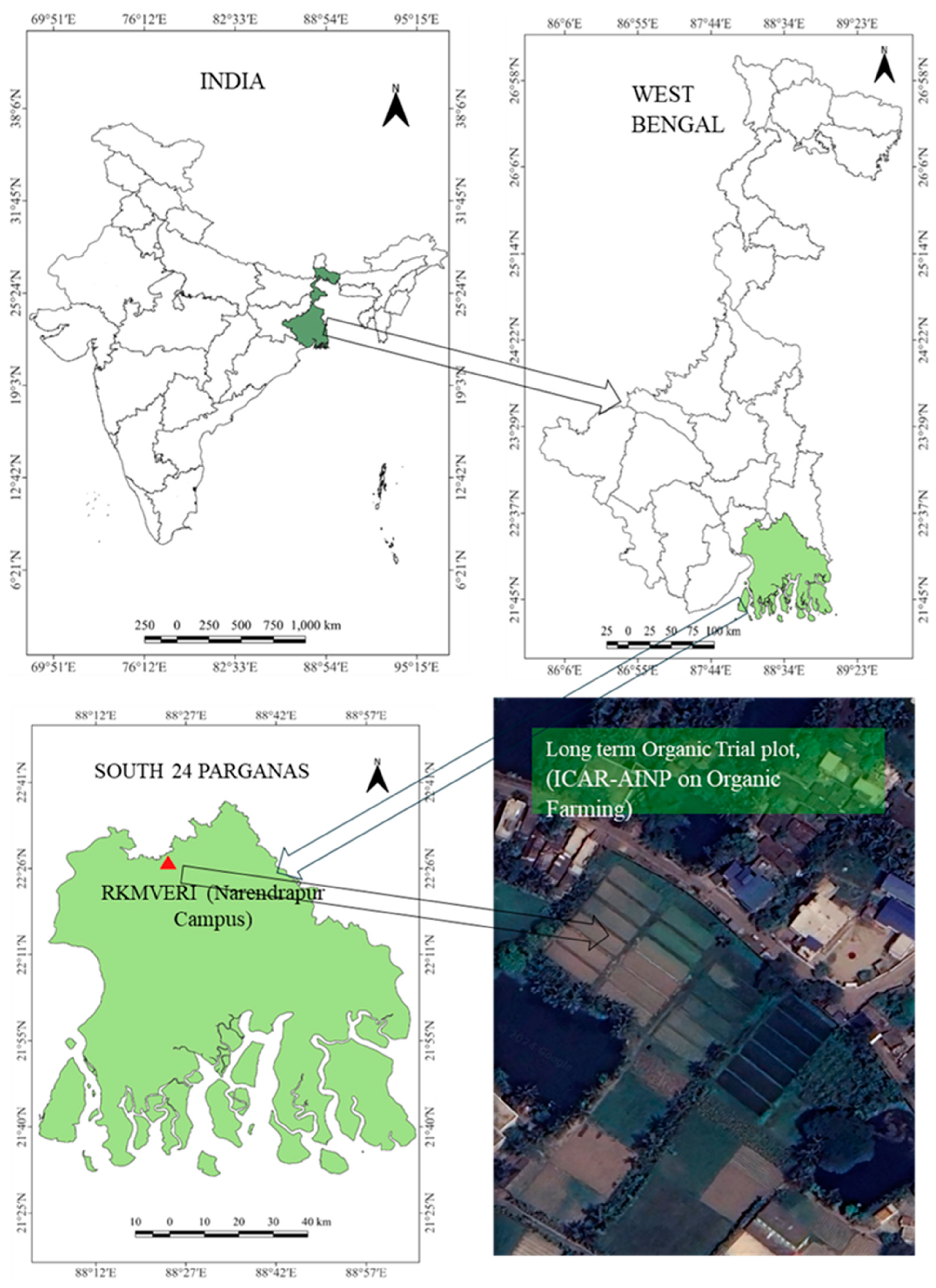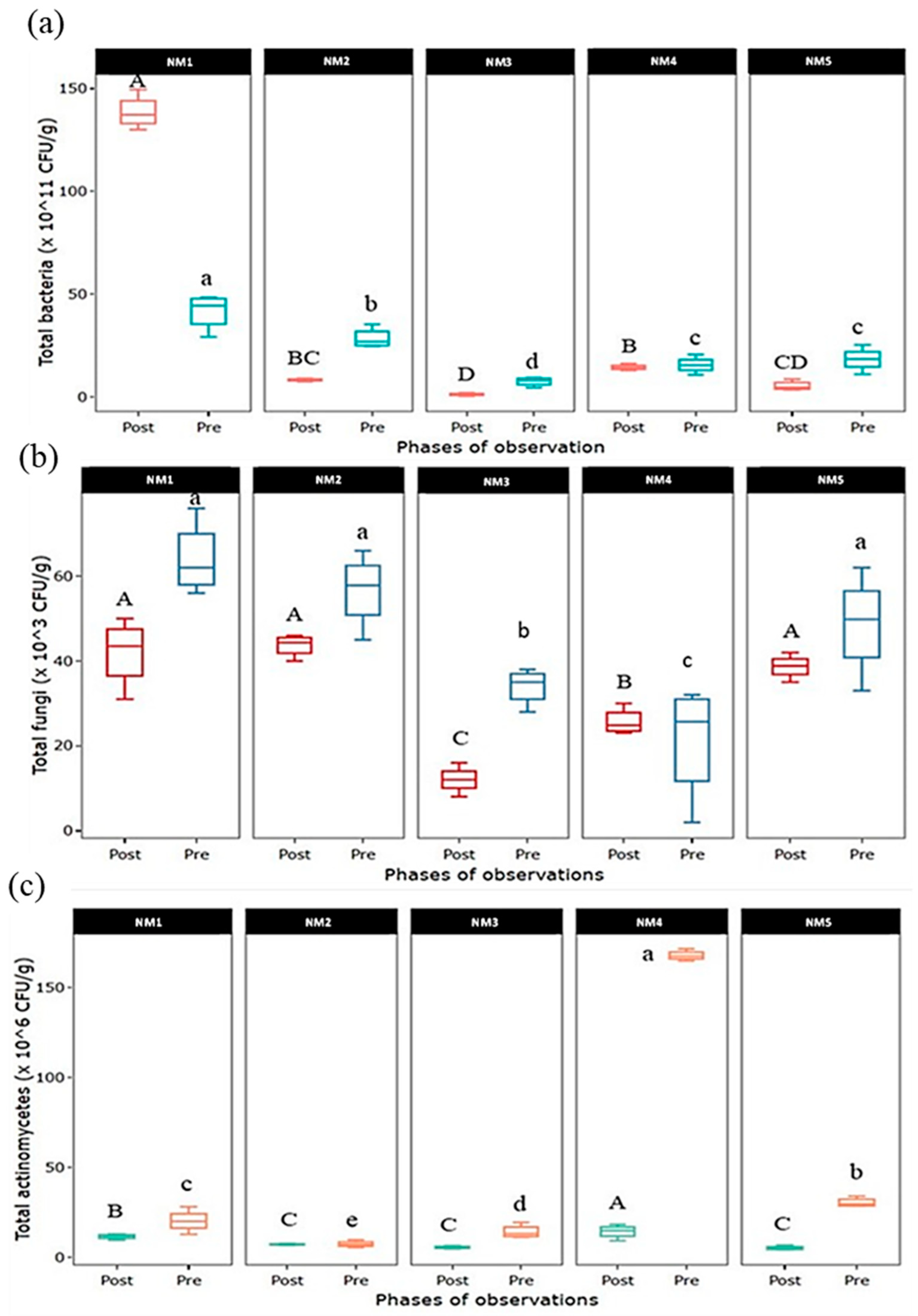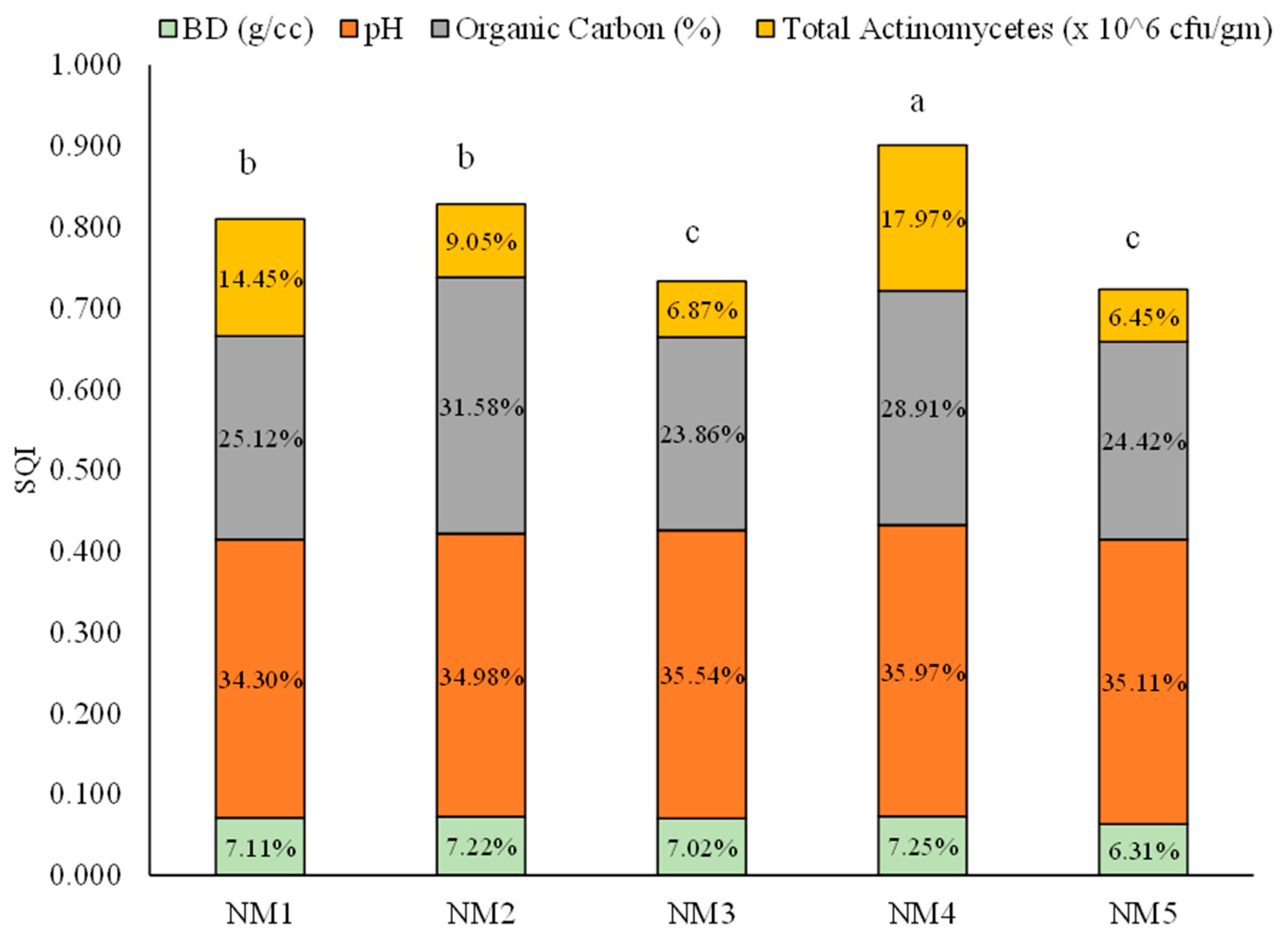1. Introduction
Rice (
Oryza sativa) is considered one of the major cereal crops for more than half of the global population [
1], while the rice-based cropping system has become the most predominant cropping practice in the Indian subcontinent [
2]. However, long-term rice-based cultivation has also led to a gradual reduction in yield and farmer income due to high input costs, improper fertilization practices, excessive soil disturbance, and reduced nutrient use efficiency [
3]. These factors are degrading the inherent capacity of soils by negatively impacting their physico-chemical properties and microbial populations [
4]. While the continuous application of chemical fertilizers may temporarily enhance crop yields by providing essential nutrients, their surplus often leads to soil organic matter degradation, loss of biodiversity, disruption of vital soil processes, and environmental pollution [
5]. Even though the wide adoption of chemical fertilizers has effectively accomplished the target of increasing agricultural productivity while ensuring self-sufficiency in food, the intensive dependency on chemicals endangers the soil microbiota and agro-ecosystem [
6]. Implementing organic manures has become a widely recognized method for enhancing soil health by boosting soil organic carbon reserves and improving nutrient use efficiency [
7]. However, organic fertilizers in single application could not sustain the long-term crop yield and productivity to feed the ever-increasing population. Therefore, a holistic approach integrating inorganic, organic, and natural input-based nutrient management would be vital to improve crop productivity, maintain soil fertility and health, and ensure environmental quality. In particular, the integration of organic manures in combination with agrochemicals is increasingly popular, which aims to improve crop yield and soil health and provide environmental safety [
8].
Natural farming is an agricultural approach that minimizes external inputs and relies on the self-sustaining principles of nature. It operates with the principle of using locally available resources while avoiding chemical fertilizers. It further emphasizes agronomic interventions, such as crop rotation, diversification, legume incorporation, efficient resource use management, and increasing nutrient use efficiency. Amongst the various components of natural farming,
Dhrava Jeevamrit and
Ghana Jeevamrit are fermented microbial consortia that enhance the activity of soil microorganisms, leading to the mineralization of essential plant nutrients and making them available for uptake by plant roots [
9].
Ghana Jeevamrit,
Dhrava Jeevamrit, and other organic inputs, such as vermicompost, compost, and farmyard manure (FYM), are incorporated in the form of dairy excreta-based solid and liquid organic manures that have improved soil organic carbon stocks [
10,
11,
12]. The combined application of these organic and inorganic inputs in the crop field ensures the availability of major plant-required nutrients by exacerbating nitrogen mineralization with the help of soil microbes [
13]. In this context, integrated nutrient-management (INM) practices are paramount for achieving sustainable production while restoring soil health and thus can be an alternate approach to agrochemicals for the farming community [
14].
In addition, integrating oilseeds and legumes into existing rice-based cropping systems, coupled with organic and natural input-based nutrients alongside the recommended NPK dosage, is essential for enhancing crop yield and improving soil fertility. In particular, the rice–mustard–green gram cropping system is well-suited for eastern India, providing a balanced production of food grains, vegetable oil, and protein [
15]. The incorporation of legumes in the rice-based cropping system helps reduce the use of agrochemicals and improves soil fertility by augmenting the soil microbial status, the organic carbon of soils, and other soil quality parameters [
16].
Soil health has become a vital factor for crop production in terms of quality and quantity, particularly in the post-Green Revolution era. Therefore, adopting suitable agro-technology to maintain soil health and quality is essential to meet the global food requirement. Soil quality indices (SQIs) are comprehensive metrics used to assess the health and functionality of the soil concerning its capacity to induce vigorous plant growth, support agricultural productivity, and regulate ecosystem balance [
17]. These indices are derived from a combination of physico-chemical and biological soil properties, viz., soil texture, organic matter content, pH, nutrient availability, microbial activity, water retention capacity, etc., and they offer a more comprehensive assessment of soil quality than investigating sole edaphic parameters [
18]. By quantifying these parameters, SQI may provide a standardized way to evaluate soil quality over time, guide sustainable land-management practices, and measure the impact of different agricultural or conservation interventions on soil health [
19].
Therefore, assessing SQIs will help achieve accurate and reliable soil quality estimation and result in effective soil health determination and management practices. The present work aims to study the effect of integrated and sole application of different off-farm and on-farm inputs as a soil quality indicator in a rice–mustard–green gram-based cropping system to achieve sustainable agricultural production.
3. Results
3.1. Soil Physico-Chemical Indicators
Natural and organic input-based integrated nutrient-management strategies significantly affected the physico-chemical parameters of soils, viz. bulk density, maximum water holding capacity, pH, electrical conductivity, oxidizable organic carbon percentage, and plant-available nitrogen, phosphorous, and potassium in the post-harvest experimental soil of the rice–mustard–green gram cropping system (
Table 4).
The BD of the post-harvest soil showed no statistically significant differences across the several nutrient treatments. The highest maximum water holding capacity (WHC) (58.52%) was observed in plots of INM practices with organic, natural, and inorganic nutrient inputs (NM4), followed closely by the 100% organic treatment (NM1) with 58.26%. At the same time, the least value was found in the integration of organic and natural inputs (50.86) (NM2).
The post-cultivation pH values were neutral (6.5–7.5), with the highest pH (7.26) in the treatment involving a mixed application of inorganic, natural, and organic inputs (NM4), while the lowest value (6.92) was recorded from 100% organic nutrient treatment (NM1). The maximum electrical conductivity (EC) (0.328) was found in treatment involving the combined application of organic and natural inputs (NM2), which was statistically at par with 100% organic treatment (0.323) (NM1). The lowest value of EC (0.200) was seen in treatment where integration of organic, natural, and inorganic inputs was applied (NM4) to meet the nutrient requirements of the crop. The highest oxidizable OC (1.12%) was recorded from the 50% organic inputs + natural inputs, and the lowest (0.82%) was seen in the case of fully inorganic treatment (NM5). A similar trend was followed in available nitrogen, depicting the highest (286 mg/kg) with the combined application of natural and organic inputs (NM2) and the lowest (204 mg/kg) in fully inorganic treatment (NM5). The highest available phosphorus (44.60 mg/kg) was recorded in the combined application of organic, inorganic, and natural inputs (NM4), which was statistically at par with the integrated application of organic and natural inputs (NM2) (44.38 mg/kg. However, 100% inorganic nutrient treatment (NM5) recorded the highest available potassium (1374 mg/kg) in the post-harvest soil and the lowest in 100% organic treatment (103 mg/kg) (NM1).
Soil OC is the key aspect of soil health and productivity. It stores nutrients and provides energy for soil organisms. The balance of OC in post-harvest soil was found to be at maximum due to the integration of organic and natural inputs (+0.25%) (NM2) followed by the addition of natural, organic, and inorganic treatments (+0.16%) (NM4) and fully organic input treatment (+0.02%) (NM1) (
Figure 3a). Fully inorganic (NM5) and integration of organic and inorganic treatment (NM3) showed a decline in organic carbon balance as compared to the initial soil by 0.04% and 0.02%, respectively (
Figure 3a). A similar result was also observed in the available nitrogen balance; the highest positive balance (+66.66 mg/kg) in the treatment where organic and natural inputs (NM2) were combined and applied was observed, followed by the integration of organic, natural, and inorganic inputs (+42.28 mg/kg) (NM4) and fully organic treatment (+30.30 mg/kg) (NM1) (
Figure 3b). The negative balance of available nitrogen was observed in fully inorganic (NM5) and integration of organic and inorganic nutrient treatment (NM3) (
Figure 3b). Irrespective of various treatment combinations, the available soil phosphrus balance was found to be negative, and the least negative value (−8.04 mg/kg) was observed with 25% organic inputs + 25% inorganic inputs + natural inputs (NM4) (
Figure 3c). The soil available potassium balance also showed a declining trend in all the treatments with a maximum negative balance in the 100% organic treatment (−64 mg/kg) (NM1) (
Figure 3d).
3.2. Soil Biological Indicators
The biological activity of soil is the function of several microorganisms present in soil. The biological properties of the post-cultivation soil, especially the microbial load (e.g., bacterial, actinomycetes, and fungi) and activity of soil dehydrogenase (DHA) enzyme, were seen to be significantly affected by various organic and natural input-based INM treatments (
Table 5)
The highest population of total bacteria (138.00 × 1011 cfu/g) in post-harvest soil was found where 100% organic inputs (NM1) were applied, and the lowest was observed with the collective application of inorganic and organic inputs (NM3). In the case of total fungi, the highest population (43.66 × 10 3 cfu/g) was found due to the combined application of natural and organic inputs (NM2) that was statistically at par with 100% organic (42 × 103 cfu/g) (NM1) and 100% inorganic (38.66 × 103 cfu/g) treatments (NM5) respectively, while the lowest was seen in the integrated application of inorganic and organic inputs (NM3). The integrated application of natural, organic, and inorganic inputs (NM4) resulted in the maximum actinomycetes load (14.30 × 106 cfu/g) in post-harvest soil.
Soil DHA was measured at 30 DAS and is represented in
Table 5. The results revealed that treatment with the integrated application of organic and natural nutrient inputs (NM2) recorded the highest dehydrogenase activity (3.45 µg TPF/g oven dry soil/24 h), and the lowest dehydrogenase activity in soil was noted with the mixed application of organic and inorganic inputs (NM3) (1.70 µg TPF g oven dry/soil/24 h).
The dynamics of soil microorganisms in the pre- and post-cultivation soil are shown in
Figure 4. In the case of the total bacterial count, the population of soil bacteria tended to decrease in all INM treatments after cultivation except in 100% organic treatment (NM1), where the status of the bacterial population was found to be much higher post-cultivation. Like bacteria, the population of fungi was also recorded to drop post-cultivation except in treatment where a combined organic, inorganic, and natural treatment (NM4) was applied, which seemed to be at the same level. In the case of soil actinomycetes, a population decline was recorded in all nutrient treatments except the integration of organic and natural input (NM2) applied treatment, which seems to be on the same level.
3.3. Soil Quality Index
A PCA was performed on 12 soil physico-chemical and biological parameters to identify the minimum data set for evaluating the soil quality index of the experimental soils. The minimum data set that includes principal components with a high eigenvalue (≥1) and a minimum 5% data variation among the principal components (PCs) was selected [
33]. The eigenvalues of the four PCs were 4.01, 3.58, 2.60, and 1.02, respectively. These, taken together, accounted for a cumulative variance of 94.3%, with the first, second, third, and fourth components explaining 34%, 29.8%, 21.6%, and 8.8% of the variability, respectively (
Table 6). For each principal component (PC), only factors with absolute values within 10% of the highest factor loading were retained for the minimum data set. Consequently, highly weighted factors like pH, organic carbon %, total actinomycetes, and bulk density were retained as PC1, PC2, PC3
, and PC4, respectively, in the minimum data set (
Table 6). The path diagram associated with the PCA is presented in
Supplementary Figure S1.
Post-formation of the minimum data set, a linear scoring technique was applied to assign a score to every individual observation of the minimum data set indicator, which ranged between 0 and 1. Upon considering whether the higher value of the indicators is good or bad for the soil, they are ranked in ascending or descending order. In our present research, bulk density was scored as “less is better”, organic carbon content and total actinomycetes were scored as “more is better”, while pH was scored as “optimum is better”. For the indicators that scored more is better, each value of the indicator was divided with the highest value (7.27 for pH, 1.14 for organic carbon, and 18.3 for total actinomycetes) such that the highest value becomes 1. In the case of the less is better indicators, the lowest value (0.87 for bulk density) was divided by each value of the indicator such that the lowest value scored a 1. The soil quality index for each PC was calculated by multiplying their respective scores with weighting factors.
where 0.36, 0.32, 0.23, and 0.09 were the weighting factors of respective PCs, and S is the score for the subscripted soil parameter.
The SQI values of all individual minimum data set components were summed to achieve a single value for each nutrient treatment. Among the five treatments, SQI varied from 0.901 to 0.723 (
Figure 5). The highest SQI was recorded from the integration of natural, organic, and inorganic inputs (0.901) (NM4), followed by the integration of organic and natural inputs (NM2) and 100% organic inputs (NM1), respectively. The contributions of minimum data set components were 35.97%, 28.91%, 17.97%, and 7.25% for pH, organic carbon %, total actinomycetes, and bulk density, respectively, in the highest SQI treatment. The lowest value of SQI was received from the fully inorganic treatment (NM5), which was statistically at par with the integration of organic and inorganic treatment.
3.4. Productivity of the Cropping System
Production of the component crops of the rice–mustard–green gram cropping system was significantly influenced by various organic and natural input-based INM strategies during the experimental period (
Table 7).
In the case of Kharif (rainy) rice, the highest yield among various nutrient-management treatments in the first year was recorded from the fully organic treatment (NM1), which was statistically at par with the integration of natural and organic inputs (NM2) and a combination of natural, organic, and inorganic inputs (NM4), respectively. Integration of organic and inorganic inputs (NM3) resulted in the maximum value of grain yield in the following year, which was at par with the integration of natural and organic inputs (NM2) and organic, inorganic, and natural inputs (NM4), respectively. A non-significant difference among treatments was observed in the third year of the experiment. In contrast, in the final year, fully organic treatment (NM1) recorded the highest grain yield, which was at par with the integration of organic and natural inputs (NM2) and the integration of organic and inorganic inputs, respectively (NM3). Through the trial period, the 100% inorganic treatment (NM5) recorded the lowest productivity of rice.
The significantly highest yield of rabi mustard in the initial year of the experiment was found from the integration of organic and natural inputs (NM2). In contrast, the second year of the experiment recorded a non-significant yield difference among treatments. In the third year, the 100% organic treatment (NM1) resulted in the highest yield, which was at par with the integration of organic and natural inputs (NM2), and in the final year, a similar trend was followed. The inorganic nutrient treatment (NM5) recorded the lowest yield throughout the experimental period.
Application of 100% organic nutrient input (NM1) resulted in the highest seed yield of green gram in the first year, which was at par with the integration of organic and natural inputs (NM2), integration of organic, natural, and inorganic inputs (NM4), and integration of organic and inorganic inputs (NM3), respectively. In 2019, due to the outbreak of the COVID-19 pandemic, the experiment could not be conducted; hence, the field was left fallow. Post-pandemic, the integration of organic and inorganic treatment (NM3) recorded the highest seed yield, which was statistically at par with the integration of organic, natural, and inorganic treatment (NM4). In the final year, the plot receiving 100% organic treatment (NM1) recorded the highest seed yield, which was at par with the integration of organic and inorganic inputs (NM2). The lowest yield was seen in the case of 100% inorganic treatment (NM5).
5. Conclusions
Integrating natural and organic inputs has proven highly effective in enhancing soil quality, a key indicator of soil health, while ensuring robust yields in the rice–mustard–green gram cropping system. These inputs, such as vermicompost, Ghana Jeevamrit, and Dhrava Jeevamrit, not only improve the physical properties of the soil by lowering bulk density but also enhance its biological activity by stimulating microbial populations. As a result, these helps improve the availability of essential nutrients, leading to improved plant growth and higher crop yields. The slow release of nutrients from organic inputs ensures a sustained supply over the cultivation time, reducing nutrient losses and promoting long-term soil fertility. Thus, integrating natural and organic inputs represents a viable, eco-friendly approach to achieving sustainable agriculture while preserving soil health for future generations.















